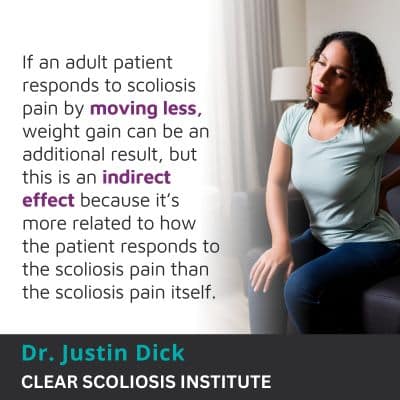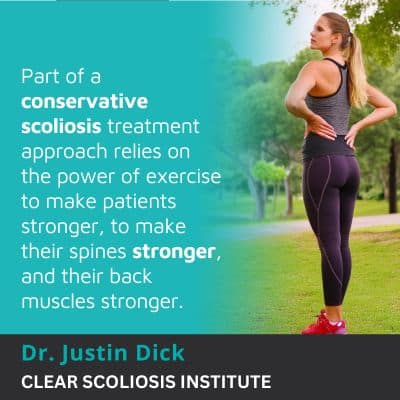![Does Scoliosis Affect Your Weight? [What You Should Know] Image](https://clear-institute.org/wp-content/uploads/2024/06/does-scoliosis-affect-your-weight.jpg)
Scoliosis is a spinal condition that disrupts the body’s symmetry through postural changes, but weight gain and/or loss isn’t considered a common effect of the condition. Scoliosis is, however, associated with some symptoms that can contribute to weight gain, and conservative scoliosis treatment can contribute to weight loss.
Weight changes aren’t a common symptom of scoliosis, but when conditions affect movement, are painful, or lead to activity restrictions, weight gain can become an indirect effect; weight loss can occur when patients commit to an exercise program as part of treatment and lifestyle changes are made.
Let’s first talk generally about scoliosis, before looking at condition variables that can lead to weight gain and/or weight loss.
Understanding scoliosis is important; not only is it a highly prevalent spinal condition affecting school-aged children, it’s also progressive in nature, meaning it’s likely to get worse over time.
Scoliosis causes an unnatural side-to-side spinal curve to develop. In addition to bending unnaturally to the side, a scoliotic spine also twists making it a 3-dimensional condition.
As a progressive condition, scoliosis is incurable, but it can be treated, and in many cases, particularly those diagnosed and treated early, the condition’s effects can be managed and minimized.
Scoliosis affects all ages, but is most prevalent in children. Scoliosis affects adults and children differently, particularly when it comes to pain and progression.
There are a number of patient and condition factors that can indirectly affect weight. Let’s start with pain and condition severity.
We all know how hard it is to stay active when pain is an issue. Whether pain increases with movement, or dealing with chronic pain depletes a person’s energy level, a sedentary response to pain can lead to weight gain.

So who is scoliosis the most likely to be painful for?
Adults are the most likely to experience scoliosis pain capable of disrupting activity levels. This is because scoliosis becomes a compressive condition when skeletal maturity is reached; this means the spine is no longer growing.
In children whose spines are still growing, the constant lengthening motion of growth counteracts the uneven pressure (compression) being introduced to the spine and its surroundings. This is the main cause of condition-related pain.
So for adults, back pain and radiating pain caused by nerve compression are common direct effects of scoliosis becoming a compressive condition.
If an adult patient responds to scoliosis pain by moving less, weight gain can be an additional result. This, however, is an indirect effect because it’s more related to how the patient responds to the scoliosis pain than the scoliosis pain itself.
There are also cases when scoliosis severity leads to activity restrictions. Anything that limits a person's activity level has the potential to contribute to weight gain.
Scoliosis severity is a key factor that shapes condition-effects; scoliosis can range from mild to moderate and severe. The more severe a condition, the more noticeable its effects are likely to be, including pain and mobility issues.
The more rotation there is in the spine, the more painful the condition is likely to be. When severe, activity restrictions can become an issue capable of contributing to weight gain.
Activity restrictions can include certain sports and exercises that are deemed unsafe for people with scoliosis. Activity restrictions aren’t always part of scoliosis treatment and life with the condition, but there are certain activities that are considered unsafe for people with certain types and/or severity levels of scoliosis.
As a scoliotic spine is already in an unnatural position, sports and activities that excessively arch or hyperextend the spine can be restricted. Muscular imbalance is considered a common effect of scoliosis. Therefore, sports and activities that overuse one side of the body can exacerbate this condition effect and should be avoided.
So for an adolescent recently diagnosed with severe scoliosis who is a competitive gymnast or tennis player, having to stop these activities, or participate in them less, can also lead to weight gain.
Now what about weight loss? Is scoliosis associated with weight loss?
Part of a conservative scoliosis treatment approach relies on the power of exercise to make patients stronger, to make their spines stronger, and their back muscles stronger.
Scoliosis-specific chiropractic corrective care works towards impacting the condition on a structural level by reducing the size of the unnatural curve and improving the spine’s alignment. However, back muscles need to be impacted as well.
It’s not just the spine that has to preserve its natural curves and healthy alignment; it’s also the role of its surrounding muscles to stabilize and support the spine during movement and rest.
Patients who commit to a successful conservative treatment approach are likely to walk away stronger. Their spines are likely to be stronger, more flexible, and the spine’s surrounding muscles are likely to be stronger and more balanced.
Increasing core strength through physical activity and the prescription of scoliosis-specific exercises, cultivates a scoliosis-friendly lifestyle that includes healthy activity levels.
So scoliosis can affect weight indirectly in both directions: weight gain and weight loss.
Another relevant question then becomes, can a person’s weight affect the onset of idiopathic scoliosis?

As the condition’s most-prevalent type that affects all ages, the etiology of idiopathic scoliosis has been the subject of many studies. Interestingly, one study found that the rate of adolescent idiopathic scoliosis was significantly higher in children with a low body mass index.
Children with a low body mass index are considered underweight, and as being underweight involves poor muscle development and strength. This may suggest that weak back muscles play a role in the development of idiopathic scoliosis in children.
After all, idiopathic scoliosis is considered to be multifactorial, meaning caused by a number of variables, and as increasing core strength is a form of treatment for scoliosis, conversely, it seems possible that weak core muscles could contribute to its onset.
So does scoliosis affect a person's weight, or does a person's weight affect scoliosis development?
As a complex condition that affects all ages, ranges widely in severity, and has different types that can develop, each patient responds to a diagnosis of scoliosis in their own way.
Some people will choose to commit to a surgical treatment approach that can lead to a spine that’s weaker, less flexible, and is more likely to have a limited range of motion, while conservative treatment involves making the spine stronger, more flexible, and more supported.
Here at the CLEAR Scoliosis Institute, the goal of treatment is to prevent progression and minimize the condition’s effects, and while weight gain isn’t a common symptom of scoliosis, for those whose conditions are painful and/or include activity restrictions, it can be an indirect result of the unnatural spinal curve’s development.
When a modern conservative treatment approach is committed to, a key facet of treatment, and of lifestyle guidance after treatment, involves the prescription of scoliosis-specific exercises and stretches.
Not only do these exercises have corrective potential, they are also important for cultivating a scoliosis-friendly lifestyle that keeps the spine and its surrounding muscles strong, flexible, and supportive.
Carrying excess weight is bad for the spine; it puts more pressure on its individual structures like the spinal discs and can increase a patient’s rate of natural age-related spinal degeneration (a contributing factor in the development of degenerative scoliosis). Therefore, maintaining a healthy weight is not just important during, but after treatment, to sustain results.
Weak back muscles are also bad for the spine, which is why some studies show low body mass index as a contributing factor in the development of idiopathic scoliosis, so staying active, strong, and maintaining a healthy weight can be important for spinal health in a number of ways.
The best way to minimize the effects of scoliosis, both direct and indirect, is to treat it proactively, and here at the Institute and by Dr. Justin Dick of CLEAR Life Scoliosis Reduction and Chiropractic, we believe in the power of a conservative treatment approach to impact scoliosis on every level for the best potential long-term treatment results.

CLEAR provides a unique and innovative way of understanding scoliosis. Sign up to receive facts and information you won’t find anywhere else.
